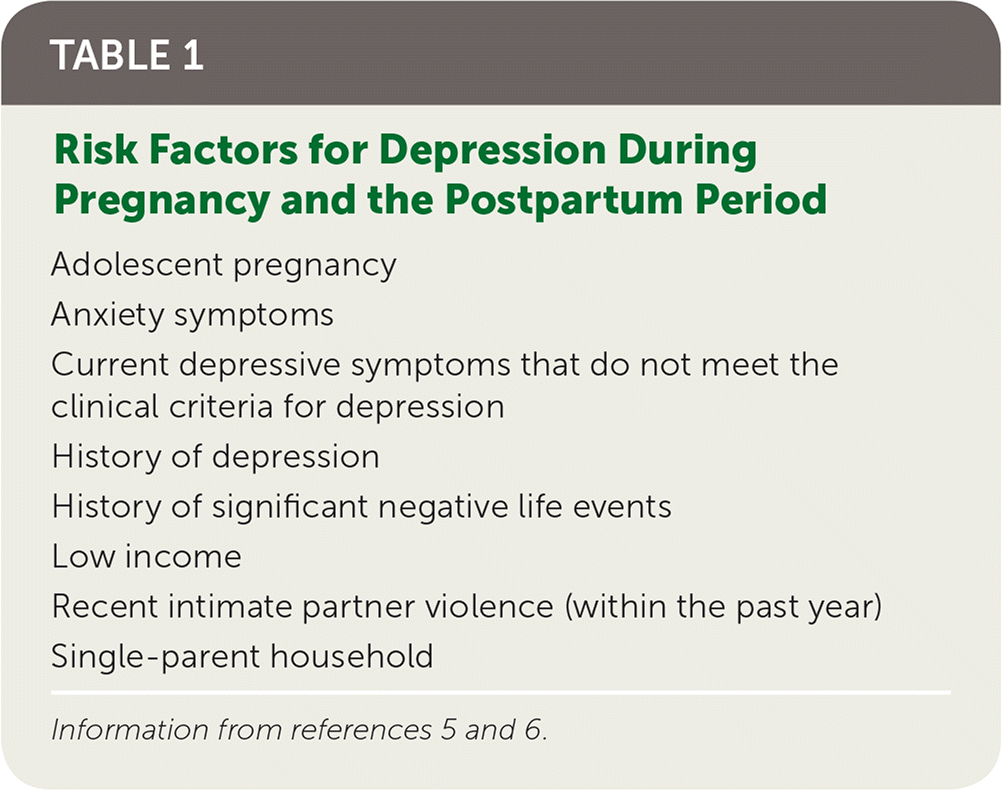
Am Fam Physician. 2019;100(6):327-328
Related Putting Prevention into Practice: Interventions to Prevent Perinatal Depression
Related USPSTF: Interventions to Prevent Perinatal Depression: Recommendation Statement
Author disclosure: No relevant financial affiliations.
As a family physician who has provided maternity care for the past 20 years, I have seen the tremendously negative effect perinatal depression can have on mothers, their families, and their communities. In 2016, the U.S. Preventive Services Task Force (USPSTF) updated its guideline on screening for depression in adults, specifically recommending screening pregnant and postpartum women for the first time.1 Few national data exist on screening rates for depression in primary care. Futhermore, the available data predate the 2016 recommendation, do not specifically mention pregnant and postpartum women, and show low rates of depression (4.4% of women of all ages).2 Universal screening in the antepartum and postpartum periods is feasible and recommended.3
The USPSTF's current guideline, which is supported by the American Academy of Family Physicians,4 recommends that clinicians “provide or refer pregnant and postpartum persons who are at increased risk of perinatal depression to counseling interventions.”5 This statement is in keeping with themes at the heart of primary care: identify individuals at increased risk of diseases that have significant physical, emotional, and societal impacts, and provide interventions proven to prevent or ameliorate these conditions. When thinking more about the practical application of the recommendation, however, the details must be examined.
The first issue is accurate identification of women who are the target of this recommendation. Unlike the multiple brief, validated, and self-administered scales that can be used for universal depression screening, the USPSTF states, “there is no accurate screening tool for identifying women at risk of perinatal depression and who might benefit from preventive interventions.”5 It is not known whether screening tools such as the Patient Health Questionnaire-2 (PHQ-2) can be used for this purpose. The USPSTF suggests that a pragmatic approach may be to use the presence of one or more risk factors to identify at-risk women (Table 15,6); however, this inefficient approach could miss high-risk women who would benefit from effective interventions or strain limited resources by over-referring women who will not ultimately develop perinatal depression.

| Adolescent pregnancy |
| Anxiety symptoms |
| Current depressive symptoms that do not meet the clinical criteria for depression |
| History of depression |
| History of significant negative life events |
| Low income |
| Recent intimate partner violence (within the past year) |
| Single-parent household |
The second issue is the appropriate treatment of women who are identified as high risk. The USPSTF found convincing evidence that cognitive behavior therapy and interpersonal therapy are effective in preventing perinatal depression in at-risk individuals. There are no data on the ideal timing for offering or referral to counseling interventions. Counseling protocols reviewed by the USPSTF were heterogeneous, ranged from four to 20 meetings, lasted a median of eight weeks, had a median contact time of 12 hours, and were conducted by a variety of clinicians, including psychologists, midwives, nurses, and other mental health professionals. If this counseling is to take place within family medicine offices, current staff require education, training, and the time to provide these services. If the counseling is to take place outside of the office, patients need access to clinicians who can provide it. The limited behavioral medicine resources in many communities and the potentially enormous number of women who could benefit from such counseling represent significant challenges to effective implementation.7
So what should a family physician do? Even if we do not provide maternity care, our commitment to the total care of our patients, which includes addressing behavioral medicine needs, allows us to be the ideal physicians to champion this intervention. Until a validated assessment tool is available, we should use the intimate knowledge of our patients, their families, and our communities to help identify at-risk patients. We should look at our current practices and communities and start the conversation about how this counseling could best be accomplished. For some, an in-house solution might work best, whereas for others building stronger community connections with mental health and maternity providers may be the preferred approach. We should advocate within our health systems and with insurers to recognize the great potential of positive outcomes for mothers and families that will result from investing in prevention. Practical recommendations for integration of mental health services into primary care practices, although not specific to perinatal depression, are a good starting point.8,9
Sometimes, if we wait until we have everything we think we might need before we move forward, vulnerable people suffer. I believe that this guideline is encouraging us to act while we build strong systems and that selectively counseling women to prevent perinatal depression is a recommendation worth supporting.
